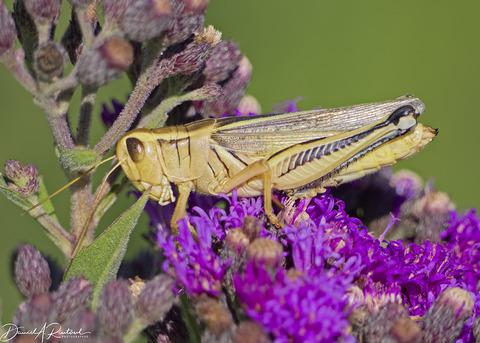当前位置:
X-MOL 学术
›
J. Anim. Ecol.
›
论文详情
Our official English website, www.x-mol.net, welcomes your feedback! (Note: you will need to create a separate account there.)
Bottom‐up when it is not top‐down: Predators and plants control biomass of grassland arthropods
Journal of Animal Ecology ( IF 4.8 ) Pub Date : 2020-03-19 , DOI: 10.1111/1365-2656.13191 Ellen A R Welti 1 , Rebecca M Prather 1 , Nathan J Sanders 2 , Kirsten M de Beurs 3 , Michael Kaspari 1
Journal of Animal Ecology ( IF 4.8 ) Pub Date : 2020-03-19 , DOI: 10.1111/1365-2656.13191 Ellen A R Welti 1 , Rebecca M Prather 1 , Nathan J Sanders 2 , Kirsten M de Beurs 3 , Michael Kaspari 1
Affiliation

|
1) We investigate where bottom-up and top-down control regulates ecological communities as a mechanism linking ecological gradients to the geography of consumer abundance and biomass. We use standardized surveys of 54 North American grasslands to test alternate hypotheses predicting 100-fold shifts in the biomass of four common grassland arthropod taxa-Auchenorrhyncha, sucking herbivores, Acrididae, chewing herbivores, Tettigoniidae, omnivores, and Araneae, predators. 2) Bottom-up models predict that consumer biomass tracks plant quantity (e.g. productivity and standing biomass) and quality (nutrient content) and that ectotherm access to food increases with temperature. Each of the focal trophic groups responded differently to these drivers: the biomass of sucking herbivores and omnivores increased with plant biomass; that of chewing herbivores tracked plant quality; and predator biomass did not depend on plant quality, plant quantity, or temperature. 3) The exploitation ecosystem hypothesis (EEH) is a top-down hypothesis that predicts a shift from resource limitation of herbivores when plant production is low, to predator limitation when plant production is high. In grasslands where spider biomass was low, herbivore biomass increased with plant biomass, whereas bottom-up structuring was not evident when spiders were abundant. Furthermore, neither predator biomass nor trophic position (via stable isotope analysis) increased with plant biomass, suggesting predators themselves are top-down limited. 4) Stable isotope analysis revealed that trophic position of the chewing herbivore and omnivore increased significantly with plant biomass, suggesting these groups increased scavenging and meat consumption in grasslands with higher carbohydrate availability. 5) Taken together, our snapshot sampling documents gradients of food web structure across 54 grasslands, consistent with multiple hypotheses of bottom-up and top-down regulation.
中文翻译:

非自上而下时自下而上:捕食者和植物控制草原节肢动物的生物量
1)我们研究自下而上和自上而下的控制在哪里调节生态群落,作为将生态梯度与消费者丰度和生物量的地理联系起来的机制。我们使用对 54 个北美草原的标准化调查来测试替代假设,这些假设预测四种常见草原节肢动物类群 - 地尾纲(Auchenorrhyncha)的生物量发生了 100 倍的变化,它们是吸食草食动物、蝗科、咀嚼食草动物、杂食动物 Tettigoniidae 和食肉动物 Araneae。2) 自下而上模型预测消费者生物量跟踪植物数量(例如生产力和常备生物量)和质量(营养成分),并且变温动物获取食物的途径随着温度增加。每个焦点营养组对这些驱动因素的反应不同:吸食草食动物和杂食动物的生物量随着植物生物量的增加而增加;咀嚼食草动物跟踪植物质量;捕食者生物量不依赖于植物质量、植物数量或温度。3) 开发生态系统假说 (EEH) 是一种自上而下的假说,它预测从植物产量低时的食草动物资源限制转变为植物产量高时的捕食者限制。在蜘蛛生物量低的草原,草食动物的生物量随着植物生物量的增加而增加,而当蜘蛛丰富时,自下而上的结构并不明显。此外,捕食者生物量和营养位置(通过稳定同位素分析)都没有随着植物生物量的增加而增加,这表明捕食者本身是自上而下的。4)稳定同位素分析表明,咀嚼草食动物和杂食动物的营养位置随着植物生物量的增加而显着增加,表明这些群体在碳水化合物供应量较高的草原上增加了食腐和肉类消费。5) 总之,我们的快照抽样记录了 54 个草原的食物网结构梯度,与自下而上和自上而下调节的多个假设一致。
更新日期:2020-03-19
中文翻译:

非自上而下时自下而上:捕食者和植物控制草原节肢动物的生物量
1)我们研究自下而上和自上而下的控制在哪里调节生态群落,作为将生态梯度与消费者丰度和生物量的地理联系起来的机制。我们使用对 54 个北美草原的标准化调查来测试替代假设,这些假设预测四种常见草原节肢动物类群 - 地尾纲(Auchenorrhyncha)的生物量发生了 100 倍的变化,它们是吸食草食动物、蝗科、咀嚼食草动物、杂食动物 Tettigoniidae 和食肉动物 Araneae。2) 自下而上模型预测消费者生物量跟踪植物数量(例如生产力和常备生物量)和质量(营养成分),并且变温动物获取食物的途径随着温度增加。每个焦点营养组对这些驱动因素的反应不同:吸食草食动物和杂食动物的生物量随着植物生物量的增加而增加;咀嚼食草动物跟踪植物质量;捕食者生物量不依赖于植物质量、植物数量或温度。3) 开发生态系统假说 (EEH) 是一种自上而下的假说,它预测从植物产量低时的食草动物资源限制转变为植物产量高时的捕食者限制。在蜘蛛生物量低的草原,草食动物的生物量随着植物生物量的增加而增加,而当蜘蛛丰富时,自下而上的结构并不明显。此外,捕食者生物量和营养位置(通过稳定同位素分析)都没有随着植物生物量的增加而增加,这表明捕食者本身是自上而下的。4)稳定同位素分析表明,咀嚼草食动物和杂食动物的营养位置随着植物生物量的增加而显着增加,表明这些群体在碳水化合物供应量较高的草原上增加了食腐和肉类消费。5) 总之,我们的快照抽样记录了 54 个草原的食物网结构梯度,与自下而上和自上而下调节的多个假设一致。



























 京公网安备 11010802027423号
京公网安备 11010802027423号